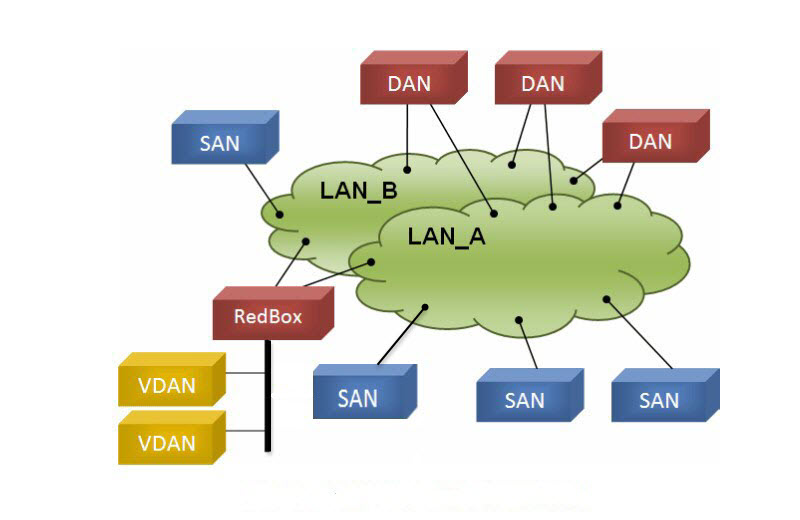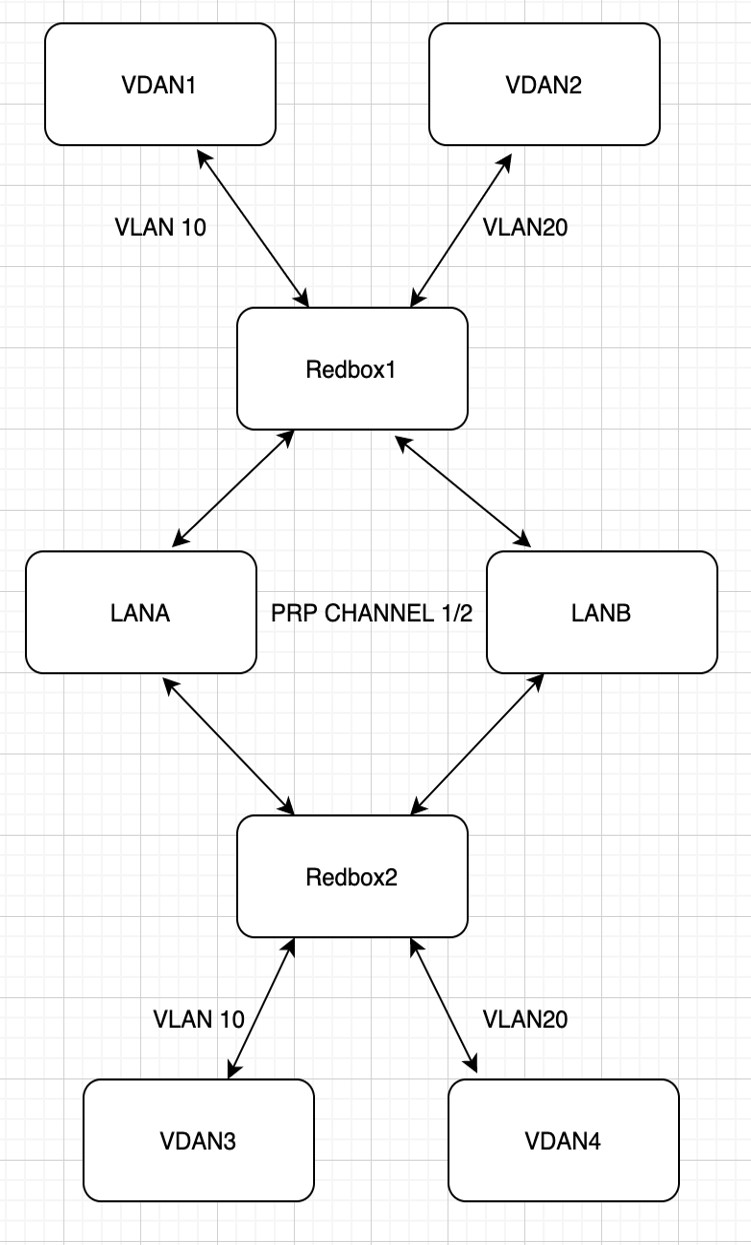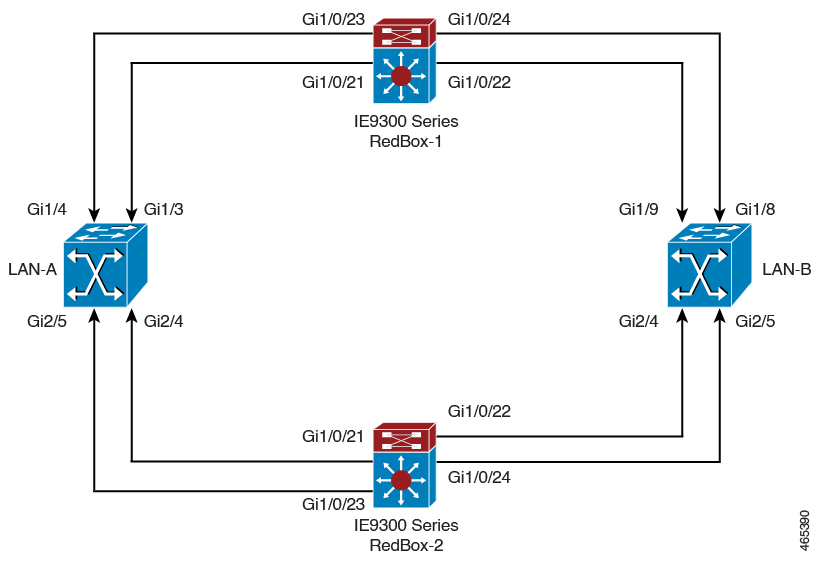Information About PRP
Parallel Redundancy Protocol (PRP) is defined in the International Standard IEC 62439-3. PRP is designed to provide hitless redundancy (zero recovery time after failures) in Ethernet networks.
 Note |
PRP is supported on several Cisco Catalyst IE9300 Rugged Series Switches: IE-9320-26S2C-Eand IE-9320-26S2C-A beginning with Cisco IOS XE Cupertino 17,7,1, and IE-9320-22S2C4X-E, and IE-9320-22S2C4X-A beginning with Cisco IOX XE Dublin 17.12.1. |
To recover from network failures, redundancy can be provided by network elements connected in mesh or ring topologies using protocols like RSTP, REP, or MRP, where a network failure causes some reconfiguration in the network to allow traffic to flow again (typically by opening a blocked port). These schemes for redundancy can take between a few milliseconds to a few seconds for the network to recover and traffic to flow again.
PRP uses a different scheme, where the end nodes implement redundancy (instead of network elements) by connecting two network interfaces to two independent, disjointed, parallel networks (LAN-A and LAN-B). Each of these Dually Attached Nodes (DANs) then have redundant paths to all other DANs in the network.
The DAN sends two packets simultaneously through its two network interfaces to the destination node. A redundancy control trailer (RCT), which includes a sequence number, is added to each frame to help the destination node distinguish between duplicate packets. When the destination DAN receives the first packet successfully, it removes the RCT and consumes the packet. If the second packet arrives successfully, it is discarded. If a failure occurs in one of the paths, traffic continues to flow over the other path uninterrupted, and zero recovery time is required.
Non-redundant endpoints in the network that attach only to either LAN-A or LAN-B are known as Singly Attached Nodes (SANs).
A Redundancy Box (RedBox) is used when an end node that does not have two network ports and does not implement PRP needs to implement redundancy. Such an end node can connect to a RedBox, which provides connectivity to the two different networks on behalf of the device. Because a node behind a RedBox appears for other nodes like a DAN, it is called a Virtual DAN (VDAN). The RedBox itself is a DAN and acts as a proxy on behalf of its VDANs.

To manage redundancy and check the presence of other DANs, a DAN periodically sends Supervision frames and can evaluate the Supervision frames sent by other DANs.
Role of the Switch
IE-9320-26S2C-A, IE-9320-26S2C-E, IE-9320-22S2C4X-A, and IE-9320-22S2C4X-E switches implement RedBox functionality using Gigabit Ethernet port connections to each of the two LANs.
PRP Channels
PRP channel or channel group is a logical interface that aggregates two Gigabit Ethernet interfaces (access, trunk, or routed) into a single link. In the channel group, the lower numbered Gigabit Ethernet member port is the primary port and connects to LAN-A. The higher numbered port is the secondary port and connects to LAN-B.
The PRP channel remains up as long as at least one of these member ports remains up and sends traffic. When both member ports are down, the channel is down. The total number of supported PRP channel groups is 2 per switch. The interfaces that you can use for each group on each switch series are fixed, as shown in the following table.
|
PRP Channel Number |
IE9300 Series |
|---|---|
|
PRP Channel 1 |
Gi1/0/21 (LAN-A) and Gi1/0/22 (LAN-B) |
|
PRP Channel 2 |
Gi1/0/23 (LAN-A) and Gi1/0/24 (LAN-B) |
Mixed Traffic and Supervision Frames
Traffic egressing the RedBox PRP channel group can be mixed, that is, destined to either SANs (connected only on either LAN-A or LAN-B) or DANs. To avoid duplication of packets for SANs, the switch learns source MAC addresses from received supervision frames for DAN entries and source MAC addresses from non-PRP (regular traffic) frames for SAN entries and maintains these addresses in the node table. When forwarding packets out the PRP channel to SAN MAC addresses, the switch looks up the entry and determines which LAN to send to rather than duplicating the packet.
A RedBox with VDANs needs to send supervision frames on behalf of those VDANs. For traffic coming in on all other ports and going out PRP channel ports, the switch learns source MAC addresses, adds them to the VDAN table, and starts sending supervision frames for these addresses. Learned VDAN entries are subject to aging.
You can add static entries to the node and VDAN tables as described in x. You can also display the node and VDAN tables and clear entries. See y and z.
VLAN Tag in Supervision Frame
Cisco Catalyst IE9300 Rugged Series Switches support VLAN tagging for supervision frames. PRP VLAN tagging requires that PRP interfaces be configured in trunk mode. This feature allows you to specify a VLAN ID in the supervision frames for a PRP channel.
In the example configuration below, PRP channel 1 interface is configured in trunk mode with allowed VLANs 10 and 20. Supervision frames are tagged with VLAN ID 10. RedBox1 sends Supervision frames on behalf of VDANs with the PRP VLAN ID, but the regular traffic from VDANs goes over the PRP channel based on the PRP trunk VLAN configuration.

See Configuring PRP Channel with Supervision Frame VLAN Tagging for configuration information.

 Feedback
Feedback